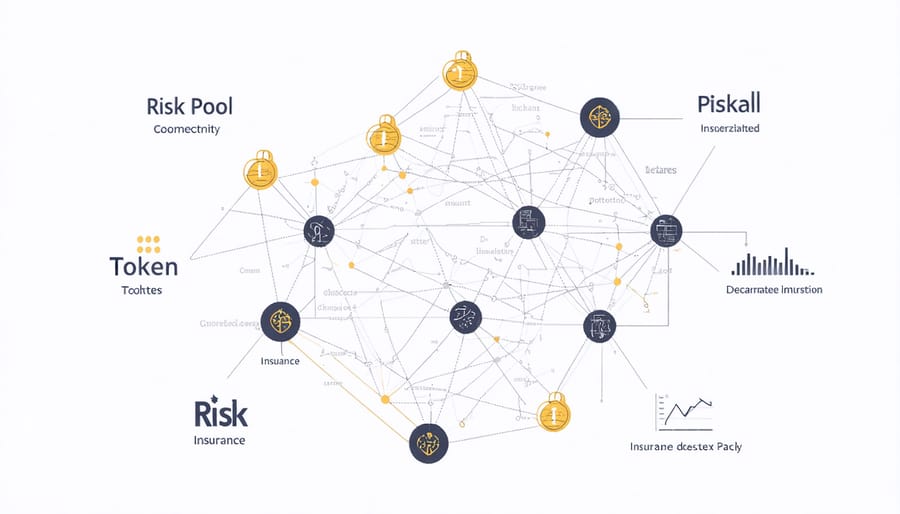In today’s digital-first real estate landscape, insurtech solutions revolutionize how we safeguard property investments and transactions. Advanced blockchain-based insurance protocols now enable real-time coverage verification, automated claims processing, and smart contract integration for protecting digital property assets with unprecedented efficiency.
Property professionals leveraging these innovations report up to 60% faster claims resolution and 40% reduction in administrative costs. From AI-powered risk assessment algorithms that precisely calculate premium rates to decentralized insurance pools offering peer-to-peer coverage options, insurtech transforms traditional property protection into a streamlined, data-driven process.
For investors and real estate professionals navigating the intersection of property technology and insurance, these solutions provide essential safeguards against digital fraud, title disputes, and smart contract vulnerabilities while maintaining compliance with evolving regulatory frameworks. The integration of IoT sensors and real-time monitoring further enhances risk management capabilities, offering proactive protection rather than reactive coverage.
This new era of property insurance technology doesn’t just optimize existing processes—it fundamentally reimagines how we approach risk management in real estate transactions.

Smart Contract Insurance: The New Frontier in Property Protection
Automated Claims Processing
The integration of AI and blockchain technology has revolutionized property insurance claims processing, transforming what was once a time-consuming ordeal into a streamlined, efficient system. Modern insurtech solutions can now process and verify claims in minutes rather than weeks, dramatically improving the experience for both property owners and insurance providers.
AI-powered systems analyze claim submissions by cross-referencing multiple data points, including property records, weather data, and historical claims patterns. When a homeowner submits a claim for storm damage, for instance, the system instantly verifies local weather events, assesses the likelihood of reported damage, and can even analyze submitted photos for authenticity.
Blockchain technology adds an extra layer of security and transparency to this process. Smart contracts automatically trigger claim payments when predetermined conditions are met, eliminating the need for manual review in straightforward cases. For example, if sensors detect water damage above a certain threshold, the system can automatically initiate the claims process and transfer funds to the policyholder.
This automated approach not only reduces processing time but also minimizes the risk of fraud. Machine learning algorithms continuously improve their ability to detect suspicious patterns, while blockchain’s immutable ledger ensures all claim-related transactions are permanently recorded and traceable.
Real-Time Risk Assessment
Modern insurtech solutions have revolutionized risk assessment in real estate transactions by implementing dynamic, real-time evaluation tools. These systems continuously monitor property conditions, market fluctuations, and transaction parameters to provide instant risk analysis for crypto property contracts.
Through advanced algorithms and AI-powered analytics, these tools can evaluate multiple risk factors simultaneously. They assess everything from property market volatility and smart contract integrity to regional economic indicators and regulatory compliance status. This comprehensive approach ensures that insurance coverage adapts to changing conditions in real-time.
What makes these tools particularly valuable is their ability to integrate data from various sources, including blockchain transaction records, property management systems, and external market databases. For instance, if a property’s smart contract shows unusual activity or market conditions shift significantly, the system automatically adjusts risk ratings and coverage recommendations.
Property investors and real estate professionals benefit from customizable risk thresholds and automated alerts. When potential risks are detected, the system can trigger immediate notifications and suggest protective measures. This proactive approach helps stakeholders make informed decisions about insurance coverage and risk management strategies, particularly crucial in the fast-moving world of crypto-based property transactions.
Blockchain-Based Property Title Insurance
Immutable Record Keeping
Blockchain technology has revolutionized the way we maintain secure property records, offering an unprecedented level of transparency and reliability in real estate transactions. This immutable record-keeping system creates a permanent, tamper-proof chain of information that documents every property-related transaction, transfer, and modification.
For property owners and real estate professionals, blockchain-based record keeping eliminates the risk of document falsification and reduces the need for time-consuming verification processes. Each transaction is automatically timestamped and encrypted, creating an unalterable audit trail that can be traced back to the property’s first recorded transaction on the blockchain.
Insurance providers benefit from this technology by accessing verified property histories, which helps them assess risks more accurately and process claims more efficiently. The decentralized nature of blockchain means that records are distributed across multiple nodes, making the system highly resistant to data loss or manipulation.
Moreover, smart contracts built on blockchain platforms can automate many aspects of property transactions and insurance processes. These self-executing contracts reduce administrative overhead and minimize the potential for human error, while ensuring that all parties meet their contractual obligations before the transaction proceeds.
For stakeholders in the real estate industry, this technological advancement represents a significant step forward in securing property investments and streamlining insurance operations.

Fraud Prevention Mechanisms
Modern insurtech solutions incorporate sophisticated fraud prevention mechanisms that leverage advanced technologies to protect property transactions and title transfers. At the forefront of these security measures is blockchain technology, which creates an immutable record of ownership history and transaction details, making title fraud significantly more difficult to perpetrate.
Machine learning algorithms continuously monitor transaction patterns and flag suspicious activities, such as multiple rapid transfers or unusual ownership claims. These systems can detect potential fraud attempts in real-time, allowing for immediate intervention before damages occur.
Digital identity verification has become another crucial component, implementing multi-factor authentication and biometric verification to ensure that only authorized parties can initiate or approve property transfers. This technology combines facial recognition, document verification, and digital signatures to create a robust security framework.
Smart contracts add an additional layer of protection by automating compliance checks and ensuring all necessary documentation is properly verified before any transaction can proceed. These self-executing contracts eliminate many opportunities for manual manipulation and fraud.
Insurance providers are also implementing artificial intelligence-powered risk assessment tools that analyze historical data, market conditions, and transaction patterns to identify potential fraud risks before they materialize. This proactive approach helps prevent fraudulent activities rather than just responding to them after the fact.
For property owners and investors, these technological safeguards provide peace of mind and significantly reduce the risk of title fraud, making property transactions more secure than ever before.
Decentralized Insurance Protocols

Community-Based Risk Pools
Community-based risk pools represent a revolutionary approach to property insurance, where groups of property owners come together to create shared insurance funds. These decentralized insurance communities operate on the principle of mutual protection, with members contributing to a collective pool that pays out when any participant faces a covered loss.
The appeal lies in the transparency and cost-effectiveness of this model. Members typically pay lower premiums compared to traditional insurance, and unused funds can be redistributed to participants at the end of each coverage period. Smart contracts automate many aspects of the process, from premium collection to claim verification, reducing administrative overhead.
For real estate investors, these pools offer unique advantages. Members often have similar property types or risk profiles, leading to more accurate risk assessment and fairer pricing. Additionally, the community aspect encourages better risk management practices, as members have a direct stake in minimizing losses.
However, it’s important to note that these pools require careful structuring and sufficient capitalization to ensure sustainable coverage. Many successful pools implement hybrid models, combining peer-to-peer coverage with traditional reinsurance for catastrophic events.
Token-Based Coverage
Token-based coverage represents a revolutionary approach in real estate insurance, allowing property owners to break down their insurance policies into digital tokens. These tokens can be easily traded, transferred, or partially sold, offering unprecedented flexibility in managing insurance coverage.
Each token represents a specific portion of the insurance policy, enabling property owners to adjust their coverage levels dynamically based on changing needs. For example, a property investor can purchase additional tokens during high-risk seasons or sell excess coverage during periods of lower risk.
The benefits of tokenized insurance policies are particularly compelling for real estate professionals. They include instant liquidity, as tokens can be bought or sold quickly on digital platforms; granular control over coverage amounts; and the ability to create custom insurance portfolios across multiple properties.
Smart contracts automatically manage these tokenized policies, ensuring transparent claims processing and reducing administrative overhead. This technology also enables fractional insurance ownership, making premium insurance products more accessible to smaller investors and property owners who previously couldn’t afford comprehensive coverage.
Implementation Strategies for Property Professionals
Successfully implementing insurtech solutions requires a strategic approach that balances innovation with practical considerations. Start by conducting a thorough assessment of your current insurance processes and identifying areas where technology can streamline operations. Consider partnering with established digital insurance solutions providers who specialize in real estate applications.
Begin with a pilot program focusing on one aspect of your insurance operations, such as claims processing or policy management. This allows you to test the system’s effectiveness while minimizing disruption to your existing workflows. Train your team thoroughly on the new technology, ensuring they understand both the technical aspects and the benefits to clients.
Implement a robust data management strategy to maximize the benefits of insurtech. This includes establishing protocols for data collection, storage, and analysis. Use the insights gained to refine your insurance offerings and improve risk assessment capabilities.
Consider these key implementation steps:
1. Start with cloud-based solutions that offer scalability and accessibility
2. Integrate mobile applications for client convenience
3. Implement automated underwriting tools for faster processing
4. Set up digital document management systems
5. Enable real-time communication channels with clients
Focus on solutions that offer strong API capabilities for seamless integration with your existing property management systems. This ensures a smooth transition and minimizes operational disruptions.
Remember to prioritize cybersecurity measures to protect sensitive client data. Regular security audits and updates should be part of your implementation strategy. Also, maintain compliance with relevant regulations by choosing insurtech solutions that meet industry standards.
Measure success through key performance indicators such as processing time reduction, client satisfaction rates, and cost savings. Use this data to make informed decisions about scaling your insurtech implementation across other areas of your business.
Stay flexible and be prepared to adjust your strategy based on feedback and results. The insurtech landscape evolves rapidly, so maintaining adaptability is crucial for long-term success.
The rapid evolution of insurtech solutions has fundamentally transformed how we approach property contract protection in the real estate industry. By leveraging artificial intelligence, blockchain technology, and automated underwriting systems, insurtech has made insurance processes more efficient, transparent, and accessible for property owners and investors alike.
These technological advancements have led to more accurate risk assessment, faster claims processing, and personalized coverage options that better serve the diverse needs of the real estate market. Smart contracts and automated claims handling have significantly reduced processing times from weeks to mere hours, while data analytics have enabled insurers to offer more competitive premiums based on real-time risk evaluation.
Looking ahead, the insurtech sector is poised for even more revolutionary changes. We can expect to see increased integration of Internet of Things (IoT) devices for real-time property monitoring, broader adoption of parametric insurance products, and more sophisticated predictive analytics for risk assessment. The growing intersection of proptech and insurtech will likely yield new hybrid solutions specifically designed for the evolving real estate landscape.
For property investors and real estate professionals, staying informed about these technological advances isn’t just beneficial—it’s essential for maintaining a competitive edge in the market. As insurtech continues to mature, we can anticipate more innovative solutions that will further streamline property protection while reducing costs and improving overall customer experience.